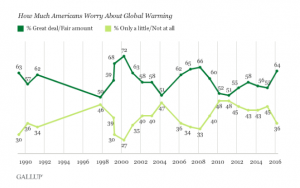While political discourse hit new lows this past year, concern for climate change hit an eight year high in 2016.
Whatever headwinds affect legislation in the new year, a number of localities, states, and organizations are taking action.
Already, 165+ jurisdictions have signed or endorsed the Under2 MOU. Together, this group including Vermont and our neighboring states, New York, Massachusetts, New Hampshire, 7 other states and five Canadian provinces among others, represents more than 1.08 billion people and $25.7 trillion in GDP, equivalent to more than a third of the global economy.
This global compact among cities, states and provinces aims to limit the increase in global average temperature to below two degrees Celsius. The Under 2 MOU calls for parties to aim to increase energy efficiency and develop renewable energy and to collaborate on climate change adaption and resilience efforts, scientific assessments, communication and public participation.
It is in this spirit of collaboration, communication, and adaption that UVM Extension Center for Sustainable Agriculture partnered with the USDA Northeast Climate Hub produced three videos showing Northeast farmers talking about their farms and how they’re experiencing climate change and are adapting with cropping strategies, water management and soil protection practices which mitigate climate impacts and help them farm successfully.
This past fall, 51.2 percent of the Northeast experienced moderate to exceptional drought, the largest extent since 2002 in the 17-year USDM record. Vermont was 3.5 F degrees warmer than its 20th century average, and this past year was the 2nd warmest year on record. period. This past fall was drier than on average, 2.38 inches less rain that the 20th century average.
In Vermont, Andy Jones, Manager, Intervale Community Farm in Burlington, VT explains how he uses irrigation to maintain soil moisture. Andy talks about his strategies in managing water, whether too much as in the summer of Tropical Storm Irene in 2011 or not enough as in this past summer 2016. Andy shares his thoughts on seeding rates and timing for the cover crops which protect the Intervale’s’s soils and shows the equipment he uses.
In New Hampshire, Pooh Sprague of Edgewater Farm, explains that even though his farm location is within feet of the Connecticut River, in dry periods, there’s no guarantee that he’ll be able to access enough water for this crops. With increasingly erratic weather in the CT river valley, Poo has increased his use of hoop houses to protect his crops and extend the growing season.
Farms aren’t built in a single person’s lifetime.
Not far from the Connecticut River, Upinngill Farm sits on a hillside overlooking the river valley. The second generation of farmers in the family, Sorrell grew up farming with her father and now has her own two children growing up on the farm. She says, “farms aren’t built in a single person’s life lifetime.”
Farmers throughout the northeast are experiencing the effects of extreme weather due to climate change and are managing their farms with the resources they can find. It’s at this community level that the Intervale Community, Edgewater, and Upinngill farms are doing their bit to adapt to the new normal of climate change.
« The summer it pays to be close to a water source for plentiful irrigation Raised Beds Raise Revenues at Golden Russet Farm »

